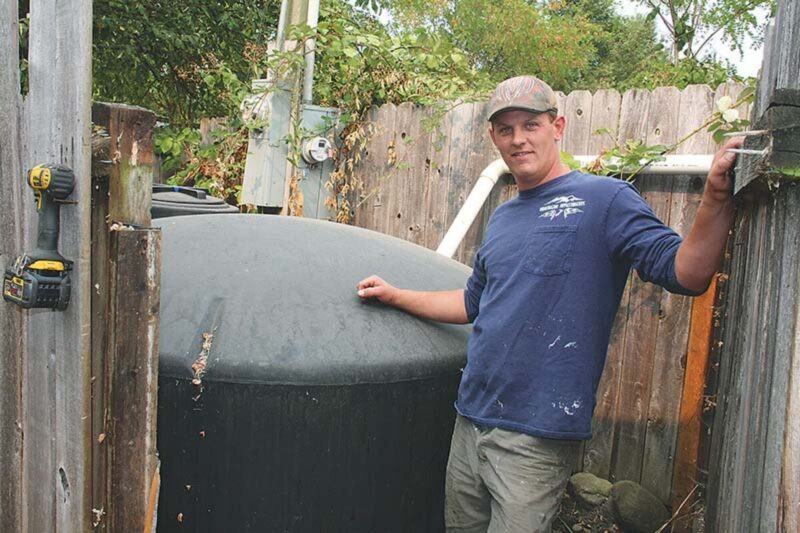Sean C. Morgan
With arsenic, diesel, heavy oil and formaldehyde well contamination detected in well water supplies of up to 40 homes, landlord Josh Victor, joined by several residents of the neighborhood around the north end of 18th Avenue, is asking the city to connect the area to city water as soon as possible.
Victor addressed the City Council during its regular meeting on Aug. 14.
In connection to an investigation into soil, groundwater and sediment contamination from the operations at the former Willamette Industries mill site at 2210 Tamarack St., the Oregon Department of Environmental Quality and Linn County offered to test wells to the northwest, where wells provide water to city residents, the north end of 18th Avenue, Willow Street and Yucca Street.
From August 2015 to September 2017, the DEQ worked with Linn County and the U.S. Environmental Protection Agency under an inter-governmental agreement and federal Brownfield Grant to investigate soil, groundwater, surface water and sediment contamination at the former mill site.
Testing indicated formaldehyde and diesel contamination at the northwest boundary of the property that was above the DEQ’s acceptable risk level for tap water, and the contamination could have been migrating toward the northwest.
Last October, the DEQ notified the Oregon Health Authority of the potential contamination, and the DEQ and county officials canvassed the neighborhood to notify residents, hand out fact sheets and request permission to sample private wells.
In November, the DEQ sampled 12 wells, finding formaldehyde in nine with concentrations higher than the DEQ’s acceptable risk level for tap water, according to a DEQ fact sheet. The test also detected diesel in two wells and heavy oil in one well at concentrations below the DEQ’s acceptable risk level for tap water.
The DEQ followed up with additional testing, using better methodology and sampling seven additional private wells in December. Those tests showed lower levels of formaldehyde contamination, not high enough to cause sudden health effects to users but which could result in increased risk of health effects, such as cancer. The agency determined that further evaluation was needed to gauge long-term risks. No diesel was detected in the December tests.
The second round of testing also detected arsenic in three wells with concentrations above the safe drinking water maximum contaminant level. According to a letter to residents, the DEQ does not believe the arsenic is from the former Willamette Industries mill site. Arsenic is elevated in groundwater in much of the Willamette Valley, due to natural causes.
In January of this year, the DEQ offered bottled water to residents because of the potential long-term cancer risk level for tap water, said Public Affairs Specialist Katherine Benenati. It was offered while Weyerhaeuser, a previous property owner, investigated the source of the formaldehyde.
From April to July, the OHA evaluated the formaldehyde risk to well owners, with preliminary results showing that current formaldehyde levels do not pose a health risk.
Weyerhaeuser’s investigation showed that formaldehyde was not detected in select wells sampled in January and June. Based on those results, the DEQ notified residents that bottled water would be discontinued on Aug. 31.
The DEQ and Weyerhaeuser did not sample again for arsenic because it was not a contaminant of concern from the mill site and is naturally occurring in the groundwater in the area, Benenati said.
Residents remain concerned about the test results, Victor said, and halting the bottled water supply is leaving residents uncertain.
In a letter from the DEQ dated Aug. 14, the DEQ informed residents that formaldehyde was not present at unsafe levels, but it did explain that some wells had tested at levels ranging from 1.54 nanograms per liter to 123 nanograms per liter. The federal safe drinking water standard is 10 nanograms per liter.
The DEQ notified the City of Sweet Home, Linn County Health and the OHA about the arsenic contamination, and the DEQ provided contact information for an OHA toxicologist for additional information about chronic arsenic exposure and attached resources for more information about testing, treatment and health effects of arsenic in drinking water and domestic water.
Victor said that two of his tenants are moving due to concerns about the contamination.
The New Era was unable to contact OHA prior to press time about its response to the arsenic contamination.
In addition to contamination issues, the wells constantly dry up, Victor said. He has filled tanks for his tenants, but other home occupants in the area cannot afford to do that. He diverts water to them as well when he has some available.
He said he doesn’t see any reason why the city cannot get water down to those residents – city water stops at Vine Street, 50 feet away north of his properties on 19th Avenue, Victor said. “We’re taxpayers too.”
Councilor James Goble asked at the Aug. 14 meeting why the city’s water service stopped short of that neighborhood. City Manager Ray Towry said it was money.
The city didn’t and doesn’t have funding necessary to extend the line, he said.
Residents of the area have at times been interested in connecting to city water, said city Staff Engineer Joe Graybill, but overall, the majority of residents in the area haven’t been willing to connect.
The city had discussions with the DEQ about grant funds when the agency was concerned about the contamination levels, Towry said, noting that “a dry well is a different situation than contamination.”
“I don’t believe in my history that any of those folks ever wanted the city’s water,” said Councilor Dave Trask.
“Well, they do now,” Victor said.
Victor told The New Era that he and other property owners in the area would happily chip in to connect their properties to city water.
Mayor Greg Mahler said the city manager would report back to the council about this issue.
“I just want to be able to tell people that live there that something’s being done,” Victor said.
The Linn County Health Department is planning a public meeting about the issue for 5:30 p.m. on Sept. 27 at the Jim Riggs Community Center.
Linn County owns the mill property under investigation. It obtained the property through foreclosure for nonpayment of property taxes in 2011 and has worked with the DEQ and U.S. Environmental Protection Agency on cleanup.
Victor said he owns about 20 properties in the area, with another 20-some properties owned by others.





